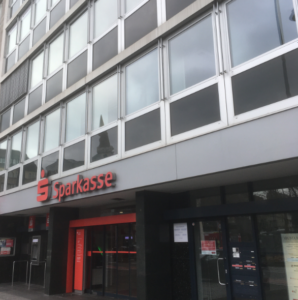If you see this after your page is loaded completely, leafletJS files are missing.

by Schüler:innengruppe Cologne
The end of apartheid in South Africa was thirty years ago. In Germany in those years, the GDR collapsed and was taken over by the Federal Republic of Germany, right-wing radicals in both East and West Germany attacked refugee shelters and murdered in Mölln, Rostock-Lichtenhagen, Solingen and elsewhere to the applause of many citizens.
Militant racism characterized the first half of the 1990s in Germany – in South Africa, at the same time, the racist laws that made life hell for the black majority were abolished. In 1994, the new South Africa emerged with Nelson Mandela as president.
For decades, the ANC, the African National Congress, had fought for this – and was supported with solidarity actions all over the world. This is also the case in Cologne.
On December 6, 1987, the Cologne City Savings Bank received a special visitor: St. Nicholas, with beard and red coat (Die Stadt, das Land, die Welt verändern. Cologne, 2014, p. 226ff). They blocked the counters and distributed leaflets to customers. They should cancel their accounts, because the savings banks were involved in the exploitation of blacks in the apartheid regime.
Until the 1990s, 300 German companies did business with the racist regime, granted loans or had production carried out in their subsidiaries, such as Mercedes Benz South Africa. German partners of the rulers in Pretoria were Bayer and Hoechst, Siemens, Bosch and AEG, Mannesmann, Krupp, Rheinmetall, MAN and MBB, BMW and VW, Deutsche Bank, Dresdner, Commerzbank and the Landesbanken. “German banks clearly financed the apartheid state” says Neville Gabriel, spokesman for the Jubilee South Africa campaign.
In 1913, the majority white South African parliament had decided to reserve 93 percent of the land for the white population. Only about 7 percent of the total area was allowed to be inhabited and cultivated by the black population. As a result, few blacks had access to land and agriculture, and were forced to work as migrant laborers in exploitative conditions in a mine or factory. The white population who owned the farms thus benefited doubly from the Natives’ Land Act: through land rights and cheap labor.
On St. Nicholas Day 1987, activists of the Cologne South Africa Committee drew barbed wire around the entrance of the savings bank in the center of the city, on Neumarkt, for a few hours. The whites used to fence off the so-called townships, i.e. the residential areas intended for blacks in the large cities of South Africa, with barbed wire. The Savings Banks have never apologized for their support of racist crimes.
For further reading:
Birgit Morgenrath (2002): Apartheid under the Good Star. In: Der Freitag from 06.12.2002
